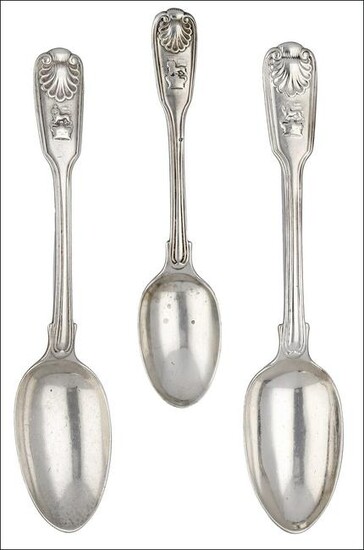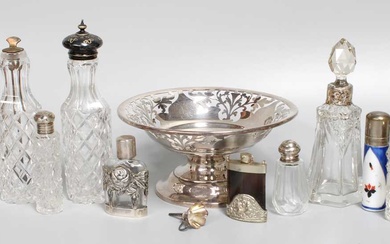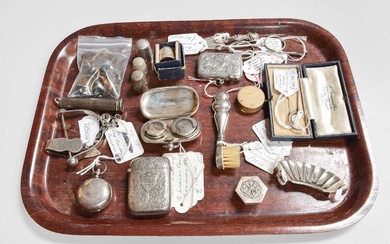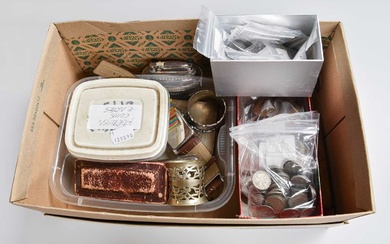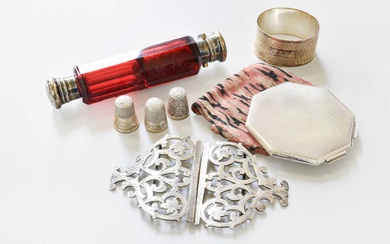Objects of Vertu
Of Regimental Interest: A pair of Victorian silver Royal Marines fiddle, thread and shell dessert spoons and a matching teaspoon, by George Adams, London, 1852, each die struck with the Royal Marines crest, (the Crowned Lion and Crown); together with a pair of George III oval silver salts, pierced decorated, on ball and claw feet, with blue glass liners, initialled, (heavily repaired), length 8.2cm. £120-£150---These three spoons form part of an official issue of silver flatware made by The Commissioners of the office of the Lord High Admiral of the United Kingdom for the Royal Marines officers mess and was first issued in 1851. See: The Finial - (the publication of The Silver Spoon Club of Great Britain), volume 17/06; Issue July/August 2007. Page 8 - makes reference to the Royal Marines die struck crest in ‘Special Commission Of Private Dies of the 19th Century, Her Majesty Queen Victoria’s Navy’ by Chris Bell.“The well-known silver manufacturer Chawner & Co. was the producer of the pattern (ie fiddle thread and shell) and the mark of George Adams, the son-in-law of Mary Chawner (widow of William Chawner), appears on pieces up to the middle of the century.The designation ‘Royal Marines’ was accorded to the Marine Corps by George III in 1802 because of the service they gave in the war with France and in 1855 the infantry companies were called the Royal Marine Light Infantry as a distinction from the Royal Marine Artillery.Some plain fiddle pattern flatware of around 1830 has been found engraved with this crest (ie the Crowned Lion and Crown). ... The die struck crest appears to have been created some twenty years later and this has been found on all flatware types including soup ladles, gravy spoons, sifter spoons, table and dessert spoons and forks but, so far, not teaspoons. The earliest date noted on these is 1851 on a table-fork of good gauge and weighing approximately 97g”.See also: Silver Flatware, English, Irish and Scottish 1600-1980 by Ian Pickford, pub. Antique Collectors’ Club, pages 150-151.------For more information, additional images and to bid on this lot please go to the auctioneers website, www.dnw.co.uk
Condition Report: The spoons are rather worn, to the scallop shells and the crests. Bowls also showing general wear and surface scratches throughout. Hallmarks on the salts appear to be spurious, maker’s mark ‘HB’ in the manner of Hester Bateman. Salts with multiple splits and repairs to the bases of both. Gross weight 160gm (5.6oz).
View it on
Estimate
Time, Location
Auction House
Of Regimental Interest: A pair of Victorian silver Royal Marines fiddle, thread and shell dessert spoons and a matching teaspoon, by George Adams, London, 1852, each die struck with the Royal Marines crest, (the Crowned Lion and Crown); together with a pair of George III oval silver salts, pierced decorated, on ball and claw feet, with blue glass liners, initialled, (heavily repaired), length 8.2cm. £120-£150---These three spoons form part of an official issue of silver flatware made by The Commissioners of the office of the Lord High Admiral of the United Kingdom for the Royal Marines officers mess and was first issued in 1851. See: The Finial - (the publication of The Silver Spoon Club of Great Britain), volume 17/06; Issue July/August 2007. Page 8 - makes reference to the Royal Marines die struck crest in ‘Special Commission Of Private Dies of the 19th Century, Her Majesty Queen Victoria’s Navy’ by Chris Bell.“The well-known silver manufacturer Chawner & Co. was the producer of the pattern (ie fiddle thread and shell) and the mark of George Adams, the son-in-law of Mary Chawner (widow of William Chawner), appears on pieces up to the middle of the century.The designation ‘Royal Marines’ was accorded to the Marine Corps by George III in 1802 because of the service they gave in the war with France and in 1855 the infantry companies were called the Royal Marine Light Infantry as a distinction from the Royal Marine Artillery.Some plain fiddle pattern flatware of around 1830 has been found engraved with this crest (ie the Crowned Lion and Crown). ... The die struck crest appears to have been created some twenty years later and this has been found on all flatware types including soup ladles, gravy spoons, sifter spoons, table and dessert spoons and forks but, so far, not teaspoons. The earliest date noted on these is 1851 on a table-fork of good gauge and weighing approximately 97g”.See also: Silver Flatware, English, Irish and Scottish 1600-1980 by Ian Pickford, pub. Antique Collectors’ Club, pages 150-151.------For more information, additional images and to bid on this lot please go to the auctioneers website, www.dnw.co.uk
Condition Report: The spoons are rather worn, to the scallop shells and the crests. Bowls also showing general wear and surface scratches throughout. Hallmarks on the salts appear to be spurious, maker’s mark ‘HB’ in the manner of Hester Bateman. Salts with multiple splits and repairs to the bases of both. Gross weight 160gm (5.6oz).
